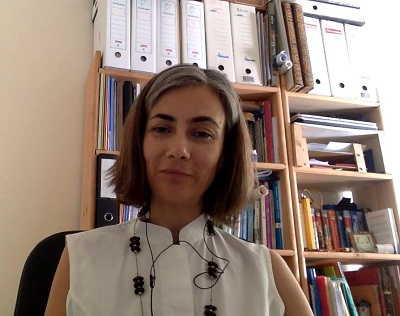Background; Dennis Hill is a biochemist who graduated from the University of Houston Texas, doing his Graduate Work at Baylor Medical School.Employed as a researcher at the renowned MD Anderson Cancer Center in Houston Texas.
Five years ago Dennis was diagnosed with aggressive stage 3 prostate cancer, thanks to cannabis oil he is now cancer free.
In the following video interview by Natalie Mazurek (2nd year chemistry student), Dennis explains in chemistry terms, how the essential oil derived from cannabis kills cancer cells.
In the interview Dennis states "how it was a trivial process using cannabis oil to cure himself of stage 3 prostate cancer.
No side effects, just a feeling of well being"
In this enlightening interview, Dennis explains in detail as only a biochemist could, how the cannabis works with the human bodies endocannabinoid system to kill cancer cells.
Dennis Hill's first Biopsy report
Dennis Hill's second biopsy report
Interview by Natalie Mazurek, applied chemistry student .
Interview glossary
Decarboxylation; (fundamental in the process of extracting cannabis oil)
Without this process the oil will not kill cancer cells!
Decarboxylation is a chemical reaction that removes a carboxyl group and releases carbon dioxide (CO2). Usually, decarboxylation refers to a reaction of carboxylic acids, removing a carbon atom from a carbon chain. The reverse process, which is the first chemical step in photosynthesis, is called carboxylation, the addition of CO2 to a compound. Enzymes that catalyze decarboxylations are called decarboxylases or, the more formal term, carboxy-lyases (EC number 4.1.1).
In organic chemistry
The term "decarboxylation" literally means removal of the COOH (carboxyl group) and its replacement with a proton. The term simply relates the state of the reactant and product. Decarboxylation is one of the oldest organic reactions, since it often entails simple pyrolysis, and volatile products distill from the reactor. Heating is required because the reaction is less favorable at low temperatures. Yields are highly sensitive to conditions. In retrosynthesis, decarboxylation reactions can be considered the opposite of homologation reactions, in that the chain length becomes one carbon shorter. Metals, especially copper compounds,[1] are usually required. Such reactions proceed via the intermediacy of metal carboxylate complexes.
reference;https://en.wikipedia.org/?title=Decarboxylation
endocannabinoid system;
The endocannabinoid system is a group of neuromodulatory lipids and their receptors in
the brain that are involved in a variety of physiological processes including
appetite, pain-sensation, mood, and memory; it mediates the psychoactive effects of
cannabis and, broadly speaking, includes:
The endogenous arachidonate-based lipids, anandamide (N-arachidonoylethanolamide,
AEA) and 2-arachidonoylglycerol (2-AG); these are known as "endocannabinoids" and are
physiological ligands for the cannabinoid receptors. Endocannabinoids are all
eicosanoids.[1]
The enzymes that synthesize and degrade the endocannabinoids, such as fatty acid
amide hydrolase or monoacylglycerol lipase.
The cannabinoid receptors CB1 and CB2, two G protein-coupled receptors that are
located in the central and peripheral nervous systems.
reference; https://en.wikipedia.org/wiki/Endocannabinoid_system
Ligand;
In biochemistry and pharmacology, a ligand is a substance that forms a complex with a
biomolecule to serve a biological purpose. In protein-ligand binding, the ligand is
usually a signal-triggering molecule, binding to a site on a target protein. In DNA-
ligand binding studies, the ligand can be a small molecule, ion,[1] or protein[2] that
binds to the DNA double helix.
reference;https://en.wikipedia.org/wiki/Ligand_%28biochemistry%29
receptors;
In biochemistry and pharmacology, a receptor is a protein molecule usually found
embedded within the plasma membrane surface of a cell that receives chemical signals
from outside the cell. When such chemical signals bind to a receptor, they cause some
form of cellular/tissue response, e.g. a change in the electrical activity of the
cell. In this sense, a receptor is a protein molecule that recognises and responds to
endogenous chemical signals, e.g. the acetylcholine receptor recognizes and responds
to its endogenous ligand, acetylcholine. However sometimes in pharmacology, the term
is also used to include other proteins that are drug targets, such as enzymes,
transporters and ion channels.
reference;https://en.wikipedia.org/wiki/Receptor_%28biochemistry%29
mimetic medicine;
Mimesis (/maɪˈmiːsəs/; Ancient Greek: μίμησις (mīmēsis), from μιμεῖσθαι (mīmeisthai),
"to imitate," from μῖμος (mimos), "imitator, actor") is a critical and philosophical
term that carries a wide range of meanings, which include imitation, representation,
mimicry, imitatio, receptivity, nonsensuous similarity, the act of resembling, the act
of expression, and the presentation of the self.[1]
In ancient Greece, mimesis was an idea that governed the creation of works of art, in
particular, with correspondence to the physical world understood as a model for
beauty, truth, and the good. Plato contrasted mimesis, or imitation, with diegesis, or
narrative. After Plato, the meaning of mimesis eventually shifted toward a
specifically literary function in ancient Greek society, and its use has changed and
been reinterpreted many times since then.
reference;https://en.wikipedia.org/wiki/Mimesis
relating to, characterized by, or exhibiting mimicry <mimetic coloring of a butterfly>
reference;http://www.merriam-webster.com/dictionary/mimetic
THC;
Tetrahydrocannabinol (THC), or more precisely its main isomer (−)-trans-Δ9-
tetrahydrocannabinol ( (6aR,10aR)-delta-9-tetrahydrocannabinol), is the principal
psychoactive constituent (or cannabinoid) of cannabis. First isolated in 1964 by
Israeli scientists Prof. Raphael Mechoulam and Dr. Yechiel Gaoni at the Weizmann
Institute of Science[8][9][10] it is a water-clear glassy solid when cold, which
becomes viscous and sticky if warmed. A pharmaceutical formulation of (−)-trans-Δ9-
tetrahydrocannabinol, known by its INN dronabinol, is available by prescription in the
U.S. and Canada under the brand name Marinol. An aromatic terpenoid, THC has a very
low solubility in water, but good solubility in most organic solvents, specifically
lipids and alcohols.[6] THC, CBD, CBN, CBC, CBG and about 80 other molecules make up
the phytocannabinoid family.
reference;https://en.wikipedia.org/wiki/Tetrahydrocannabinol
cbd (cannabidiol)
Cannabidiol (CBD) is one of at least 85 active cannabinoids identified in cannabis.[4]
It is a major phytocannabinoid, accounting for up to 40% of the plant's extract.[5]
CBD is considered to have a wider scope of medical applications than
tetrahydrocannabinol (THC).[5] An orally-administered liquid containing CBD has
received orphan drug status in the US, for use as a treatment for Dravet syndrome,
under the brand name Epidiolex.[6]
reference;https://en.wikipedia.org/wiki/Cannabidiol
Endogenous( made within the body)
Endogenous substances are those that originate from within an organism, tissue, or
cell.[1]
Endogenous viral elements (EVEs) are DNA sequences derived from viruses that are
ancestrally inserted into the genomes of germ cells. These sequences, which may be
fragments of viruses, or entire viral genomes (proviruses), can persist in the
germline, being passed on from one generation to the next as host alleles.
Endogenous processes include senescence, the menstrual cycle and the self-sustained
circadian rhythms of plants and animals.
In some biological systems, endogeneity refers to the recipient of DNA (usually in
prokaryotes). However, because of homeostasis, discerning between internal and
external influences is often difficult.
Endogenous transcription factors refers to those that are manufactured by the cell, as
opposed to cloned transcription factors.
reference;https://en.wikipedia.org/wiki/Endogeny_%28biology%29
Exogenous ( outside of the body , ex plants)
In biology, an exogenous contrast agent in medical imaging for example, is a liquid
injected into the patient intravenously that enhances visibility of a pathology, such
as a tumor. An exogenous factor is any material that is present and active in an
individual organism or living cell but that originated outside of that organism, as
opposed to an endogenous factor.
Exogenous factors in medicine include both pathogens and therapeutics.
DNA introduced to cells via transfection or viral infection (transduction) is an
exogenous factor.
Carcinogens are exogenous factors.
reference;https://en.wikipedia.org/wiki/Exogeny
Biomimetic;
Biomimetics or biomimicry is the imitation of the models, systems, and elements of
nature for the purpose of solving complex human problems.[1] The terms biomimetics and
biomimicry come from Ancient Greek: βίος (bios), life, and μίμησις (mīmēsis),
imitation, from μιμεῖσθαι (mīmeisthai), to imitate, from μῖμος (mimos), actor. A
closely related field is bionics.[2]
reference;https://en.wikipedia.org/wiki/Biomimetics
Anandamide;
Anandamide, also known as N-arachidonoylethanolamine or AEA, is an endogenous
cannabinoid neurotransmitter. The name is taken from the Sanskrit word (and Hinduistic
religious term) ananda, which means "joy, bliss, delight", and amide.[1][2] It is
synthesized from N-arachidonoyl phosphatidylethanolamine by multiple pathways.[3] It
is degraded primarily by the fatty acid amide hydrolase (FAAH) enzyme, which converts
anandamide into ethanolamine and arachidonic acid. As such, inhibitors of FAAH lead to
elevated anandamide levels and are being pursued for therapeutic use.[4][5]
reference;https://en.wikipedia.org/?title=Anandamide
cb1;
Cannabinoid receptors are part of the cannabinoid receptor system in the brain and are
involved in a variety of physiological processes including appetite, pain-sensation,
mood, and memory.
Cannabinoid receptors are of a class of cell membrane receptors under the G protein-
coupled receptor superfamily.[1][2][3] As is typical of G protein-coupled receptors,
the cannabinoid receptors contain seven transmembrane spanning domains.[4] Cannabinoid
receptors are activated by three major groups of ligands, endocannabinoids (produced
by the mammilary body), plant cannabinoids (such as Cannabidiol, produced by the
cannabis plant) and synthetic cannabinoids (such as HU-210). All of the
endocannabinoids and plant cannabinoids are lipophilic, such as fat soluble compounds.
reference;https://en.wikipedia.org/wiki/Cannabinoid_receptor
Cannabinoid;
Cannabinoids are a class of diverse chemical compounds that act on cannabinoid
receptors on cells that repress neurotransmitter release in the brain. Ligands for
these receptor proteins include the endocannabinoids (produced naturally in the body
by humans and animals),[1] the phytocannabinoids (found in cannabis and some other
plants), and synthetic cannabinoids (manufactured artificially). The most notable
cannabinoid is the phytocannabinoid tetrahydrocannabinol (THC), the primary
psychoactive compound of cannabis.[2][3] Cannabidiol (CBD) is another major
constituent of the plant.[4] There are at least 85 different cannabinoids isolated
from cannabis, exhibiting varied effects.[5]
reference;https://en.wikipedia.org/wiki/Cannabinoid
signalling metabolites;
Metabolites are the intermediates and products of metabolism. The term metabolite is
usually restricted to small molecules. Metabolites have various functions, including
fuel, structure, signaling, stimulatory and inhibitory effects on enzymes, catalytic
activity of their own (usually as a cofactor to an enzyme), defense, and interactions
with other organisms (e.g. pigments, odorants, and pheromones). A primary metabolite
is directly involved in normal "growth", development, and reproduction. Ethylene is an
example of a primary metabolite produced in large-scale by industrial microbiology. A
secondary metabolite is not directly involved in those processes, but usually has an
important ecological function. Examples include antibiotics and pigments such as
resins and terpenes etc.
reference;https://en.wikipedia.org/wiki/Metabolite
Ceramide;
Ceramides are a family of waxy lipid molecules. A ceramide is composed of sphingosine
and a fatty acid. Ceramides are found in high concentrations within the cell membrane
of cells. They are one of the component lipids that make up sphingomyelin, one of the
major lipids in the lipid bilayer. Contrary to previous assumptions that ceramides and
other sphingolipids found in cell membrane were purely structural elements, ceramide
can participate in a variety of cellular signaling: examples include regulating
differentiation, proliferation, and programmed cell death (PCD) of cells.
reference;https://en.wikipedia.org/wiki/Ceramide
Exo–cannabinoids;
Phyto–cannabinoids, also known as cannabinoids or exo–cannabinoids, are differentiated
from endo-cannabinoids due to their production from enzymes in a plant opposed to
being manufactured in a human, or better yet, a mammal. Cannabinoids come in many
shapes and functions. Today, there are many known unique phytocannnabinoids and
synthetic cannabinoids. Laboratories, like Montana Biotech, are currently assisting in
cannabinoid testing. This service can help patients get the most from this ancient
plant, cannabis.
Peptides;
Peptides (from Gr. πεπτός, "digested", derived from πέσσειν, "to digest") are
naturally occurring biological molecules. They are short chains of amino acid monomers
linked by peptide (amide) bonds. The covalent chemical bonds are formed when the
carboxyl group of one amino acid reacts with the amino group of another. The shortest
peptides are dipeptides, consisting of 2 amino acids joined by a single peptide bond,
followed by tripeptides, tetrapeptides, etc. A polypeptide is a long, continuous, and
unbranched peptide chain. Hence, peptides fall under the broad chemical classes of
biological oligomers and polymers, alongside nucleic acids, oligosaccharides and
polysaccharides, etc.
reference;https://en.wikipedia.org/?title=Peptide
Metastatic lesion
Metastasis, or metastatic disease, is the spread of a cancer or disease from one organ
or part to another not directly connected with it. The new occurrences of disease thus
generated are referred to as metastases /mə ˈtæs tə siːz/ (sometimes abbreviated
"mets").[1][2] It was previously thought that only malignant tumor cells and
infections have the capacity to metastasize (also spelled metastasise); however, this
is being reconsidered due to new research.[3] Metastasis is a Greek word meaning
"displacement", from μετά, meta, "next", and στάσις, stasis, "placement".
reference;https://en.wikipedia.org/wiki/Metastasis
Carboxylation;
Carboxylation in biochemistry is a posttranslational modification of glutamate
residues, to γ-carboxyglutamate, in proteins. It occurs primarily in proteins involved
in the blood clotting cascade, specifically factors II, VII, IX, and X, protein C, and
protein S, and also in some bone proteins. This modification is required for these
proteins to function. Carboxylation occurs in the liver and is performed by γ-glutamyl
carboxylase.[4]
The carboxylase requires vitamin K as a cofactor and performs the reaction in a
processive manner.[5] γ-carboxyglutamate binds calcium, which is essential for its
activity.[6] For example, in prothrombin, calcium binding allows the protein to
associate with the plasma membrane in platelets, bringing it into close proximity with
the proteins that cleave prothrombin to active thrombin after injury.[7]
reference;https://en.wikipedia.org/wiki/Carboxylation
ATP;
Adenosine triphosphate (ATP) is a nucleoside triphosphate used in cells as a coenzyme,
often called the "molecular unit of currency" of intracellular energy transfer.[1]
ATP transports chemical energy within cells for metabolism. It is one of the end
products of photophosphorylation, cellular respiration, and fermentation and used by
enzymes and structural proteins in many cellular processes, including biosynthetic
reactions, motility, and cell division.[2] One molecule of ATP contains three
phosphate groups, and it is produced by a wide variety of enzymes, including ATP
synthase, from adenosine diphosphate (ADP) or adenosine monophosphate (AMP) and
various phosphate group donors. Substrate-level phosphorylation, oxidative
phosphorylation in cellular respiration, and photophosphorylation in photosynthesis
are three major mechanisms of ATP biosynthesis.
reference;https://en.wikipedia.org/?title=Adenosine_triphosphate
mitochondrial (mt) membrane;
Mitochondrial membrane transport proteins are proteins which exist in the membranes of
mitochondria and which serve to transport[1] molecules and other factors such as ions
into or out of the organelles.
reference;https://en.wikipedia.org/wiki/Mitochondrial_membrane_transport_protein
Endoplasmic reticulum;
The endoplasmic reticulum (ER) is a type of organelle in the cells of eukaryotic
organisms that forms an interconnected network of flattened, membrane-enclosed sacs or
tubes known as cisternae. The endoplasm is the inner core of the cytoplasm and the
membranes of the ER are continuous with the outer membrane of the nuclear envelope.
reference;https://en.wikipedia.org/wiki/Endoplasmic_reticulum
2-AG (2-Arachidonoylglycerol)
2-Arachidonoylglycerol (2-AG) is an endocannabinoid, an endogenous agonist of the CB1 receptor.[1][2] It is an ester formed from the omega-6 fatty acid arachidonic acid and glycerol. It is present at relatively high levels in the central nervous system, with cannabinoid neuromodulatory effects. It has been found in maternal bovine and human milk. The chemical was first described in 1994-1995, although it had been discovered some time before that. The activities of Phospholipase C (PLC) and diacylglycerol lipase (DAGL) mediate its formation. 2-AG is synthesized from arachidonic acid-containing diacylglycerol (DAG).
Latest
Coronavirus Strikes Massachusetts Cannabis Company Employees
Reassessing the Essential: Cannabis in the Time of a Pandemic
5 Reasons To Try Aspen Valley CBG Flower (30% Off)
High Times Cannabis Cups Go Virtual In Wake Of Coronavirus Pandemic
Drug Enforcement Administration Proposes Plan To Expand Cannabis Research
Ghana Legalizes Cannabis For Medicinal And Industrial Uses
The cheapest legal weed in Canada: Discover these cannabis ‘value brands’
Cannabis and coronavirus: Here’s what you need to know
cannabis designs
The Best Of
WHO Rules CBD Should Not Be a Scheduled Drug

Dr Cristina Sanchez PhD video interview on medical marijuana and cancer

Biochemist Dennis Hill interview; Cannabis oil as a cure for cancer.

The unofficial World Record holder for cannabis smoking part 1





